| (ARCHIVE) Vol. XX No. 3, may 16-31, 2010 |
|
Quick Links
The Gujaratis of Madras: Merchants, traders & educationists
A temple where the past has disappeared!
The most bang for your buck
Another who was mentored by G.H. Hardy
On the Bookshelves
|
|
Two families that were into a variety of businesses were the Lodd family and the Khusaldoss family. The Lodds were wealthy businessmen whose philanthropy was legendary. Two prominent members of this family were Krishnadas Balamukundas and his son Lodd Govindoss. Krishnadas Balamukundas was born in Mysore in 1821 and, when he was 13, came to Madras where he began a number of successful business enterprises, such as dealing in diamonds, pearls, rubies, and emeralds, banking, lending money on estates. Patter’s Gardens, the home of the Lodd family on General Patter’s Road played host during visits by many prominent people, including Swami Vivekananda in 1897. The Music Academy held its Annual Conference at Patter’s Gardens in 1937. The descendants of the Lodd family are today into diverse fields such as law and engineering. A detailed account of the family was published as a two-part series in Madras Musings in May 2000.
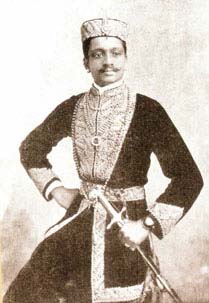
Lodd Govindoss
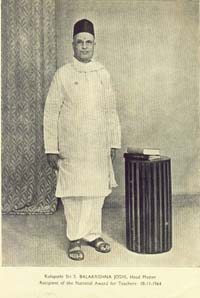
Kulapathi Balakrishna Joshi
|
The firm of Chathoorbhooja Doss Khushal Doss & Sons was first established in 1828 with its primary business being banking, and trading in silk, musk and spices. Over the course of the next century, several other businesses were added. The firm was also managing agent for the Burmah Oil Company and it carried out extensive trade in oil under the name M/s. Baniams & Co. The best known face of this firm was Dewan Bahadur Govindoss Chatoorbhujadoss who became Sheriff of Madras in 1913 at the young age of 35.
Merchants & traders
Adam Hajee Mohammed Sait belonged to the Cutchi Memon community, a community of Muslims who migrated from Kachch in Gujarat. He arrived in Madras from Cochin in 1909 and soon started a business dealing in tobacco and general merchandise. He was the first Cutchi Memon to be conferred the title ‘Khan Bahadur’ by the British. He held positions such as Sheriff of Madras and the President of the South Indian Chamber of Commerce. He was one of the founding directors of Rane’s. When Sir James Taylor was the Governor of the Reserve Bank of India, Adam Hajee Mohammed Sait was made a Reserve Bank Director representing the Madras Province. He was associated with the South India Athletic Association. A multi-faceted personality, he even knew the art of removing poison from a scorpion bite!
Adam Hajee Mohammed Sait and Sons were sole agents for the Kerala Soap Institute, Calicut, sub-agents for Lipton tea, distributors for Nestle and Anglo Swiss Condensed Milk (Export) Co. Ltd., Parry’s Confectionery and Mcdowell Britannia Biscuits. The business still functions from 44 Bunder Street and is run by the grandson of Adam Hajee Mohammed Sait.
Poppat Jamal was originally from Gujarat and worked for Ibrahim Peer Mohammad and Co., dealers in crockery and glass on Broadway. In 1901, the owner decided to sell the business and Poppat Jamal bought it and renamed it Poppat Jamal and Brothers. It was renamed Poppat Jamal and Sons in the 1920s and is still a big name in the field of crockery, with branches in the city and Vijayawada, Kochi, Bangalore and Mumbai. A line of business added in the mid-1960s was the retailing of music.
Currimbhoy’s was started by Karim Bhai, a Gujarati who came to Madras in the late 1800s and gained popularity by selling lanterns and chimneys in Parrys. He later diversified into dealing in crockery and cutlery and, in 1939, the Evening Bazaar shop was opened. The shop still remains a popular shopping destination for crockery and cutlery.
Gujarati contributions
to charity
.jpg)
George V of George Town
|
The South Indian Humani-tarian League was founded by a group of Jain Gujaratis in December 1926. The main objectives of the League were promotion of humanitarianism, vegetarianism, and abolition of animal sacrifice. Towards the accomplishment of its objectives, the League organised lectures, held audio-visual shows featuring short films on a bioscope, and published booklets, posters and leaflets. It was successful in stopping the practice of animal sacrifices at many temples. The proprietors of Elphinstone Bioscope, Crown Theatre, Kinema Central (now Murugan Talkies) and Cinema Majestic showed short films propagating animal protection and helped the cause of the League. Many dignitaries, such as Kamala Devi Chattopadhyaya, T.V. Kalyanasundaram Mudaliar and S. Satyamurthi, were active spokespersons for the League. Annie Besant and Sriman Srinivasa Aiyangar were also at different times Presidents of the organisation.
One of the major contributions of Dewan Bahadur Govindoss Chatoorbhujadoss to the city was the funding of the statue of King George V that can still be seen today outside the Flower Bazaar police station. It was raised there in 1914. He also played a crucial part in the setting up of the Madras Pinjrapole in Ayanavaram. Many organisations in the Madras Presidency benefited from his munificence. One example was the setting up of a science hall and laboratory named after Lord Pentland in the Srirangam High School.
Krishnadas Balamukundas of the Lodd family involved himself in a number of social causes, prominent amongst them being the contribution of Rs.20,000 towards the construction of a permanent building for the Chennapuri Annadana Samajam in Nainiappa Naicken Street in Sowcarpet, a building that still stands. Another significant contribution was the selling of his house Umda Bagh along with its grounds to the Government for a price considerably less than its market value as the building was to be used for educational purposes. The statue of King Edward VII, which until recently stood outside the gates of Government Estate, was his gift to the city and was unveiled in June 1903.
Lodd Govindoss, the son of Krishnadas Balamukundas, was also a well known public figure. He was elected as representative of the 3rd Division of the Municipality of Madras in 1900. His philanthropic activities included contribution towards setting up the Madras Pinjrapole in Ayanavaram and a Babies’ Home whose object was to render help to poor mothers in bringing up their babies by providing milk necessary for nourishment. He was also a member of the first Board of Directors of the Indian Bank.
The list of families and personalities covered in this series is by no means exhaustive and is only representative of the community which has, by dint of its hard work and philanthropy, left an indelible mark on the city. |
Yoonus Sait and Sons, a business that still functions from Rattan Bazaar, was established in 1905 and remains a popular destination for woollen clothing. It also used to provide the Sheriffs of Madras with their ceremonial attire.
Some other businessmen about whom little is known were:
‘Rajavaidya’ Narayanji Keshavji: An Ayurveda practitioner who published a pamphlet in Gujarati and in languages such as Tamil and Malayalam. Titled Vaidya Vidya, it prescribed simple remedies for various diseases. His Ayurveda Aushadalayam functioned from 20 China Bazaar Road.
Bachu Sait, a tea merchant, who functioned from 246 China Bazaaar Road.
Shaik Adam & Sons of 21 Errabalu Chetty Street were specialists in pith turbans and were official outfitters for the Army, Police and Fire Services.
Abdool Hoossain Jeevajee & Co of 9 Linghi Chetty Street were ship chandlers, importers of hardware and building materials, and suppliers to the Railways.
L. Madar Saib’s business specialised in motor hood cloths and carriage rubber tyres and operated from 104 Mannady.
Education
Two Gujaratis who made their name as educationists were Sivasankara Pandya and Kulapathi Balakrishna Joshi.
R. Sivasankara Pandya was the founder of the The Hindu Theological High School on Mint Street. His life sketch was published in Madras Musings on September 1, 2008.
S. Balakrishna Joshi, born in 1910 in Madras, graduated in 1929 from Presidency College and joined the Hindu Theological High School, his alma mater, as a teacher the same year. He became its Principal in 1944 and held the post till 1970, when he retired at the age of 60.The school gained great prominence during his time. He was the recipient of a National Award for Teachers in 1964. M. Bhaktavatsalam, the then Chief Minister of Tamil Nadu, presented him with a purse of Rs. 25,000 as a token of appreciation of his receiving the award. Such was his commitment to education that he donated the entire amount to the School. The title of Kulapathi was bestowed on him by the Paramacharya of Kanchi the same day he was awarded the National Award.
After retiring from the Hindu Theological High School, he served, in turn, as the Founder Principal of two educational institutions that are prominent in the city today: the D.A.V. Higher Secondary School (between 1970 and 1975) and the Sindhi Model School (between 1975 and 1978). Kulapathi Balakrishna Joshi passed away in 1992. The Sri Balakrishna Joshi Gurukulam, a school in his name, was started a few years ago at Kolathur by his old students.
(Concluded)
Acknowledgements
P.Haridas, a scion of the Gokuldas Jamnadas family, for introducing the author to a book on the Madras Presidency written in Gujarati and published in 1928 under the title Madras Ilaakaanu Digdarshan (An overview of the Madras Presidency).
The author’s aunt, Sandhya Davey, for the translation of the relevant subjects in the book.
Two Worthies of Southern India being the Memoirs of Krishnadas Balamukundas and Lodd Govindoss by A. Vadivelu, 1902.
Southern India: Its History, People, Commerce and Industrial Resources by Somerset Playne, 1914.
V. Sriram for several inputs.
Back to top
|
|
|
|
|
You could easily mistake it to be a temple constructed in recent times. But it belongs to the era of the mighty Chola monarchs. That’s certainly difficult to believe, as it today stands bereft of many of its ancient features, such as some of the historical inscriptions that once adorned its walls. More about these epigraphs later.
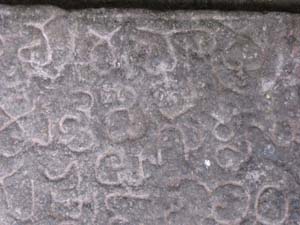
An inscription in the temple and a decorative motif, Karneeshwarar Temple, Bazaar Street, Mylapore.
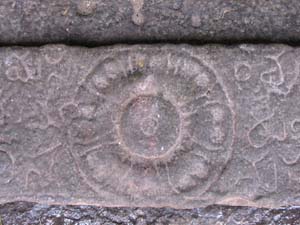
|
The Karneeshwarar Temple in Mylapore, dedicated to Siva, is on the ever-busy Bazaar Street. Facing east, the main sanctum sanctorum houses a Siva Linga while the smaller one for Parvati, enshrined here as Porkkodi Amman, faces south. The entrance to both these shrines is via a mantapa with pillars that bespeak Chola workmanship. This pillared hall has a small niché, facing west, housing an image of Surya with a lotus in each hand and with a significant halo around the head.
Near this deity are the stone images of four Saiva saints, Appar, Tirugnanasambandar, Sundaramurti and Manickavachagar. The first three were the Devaram hymners. Manickavachagar of the 9th Century was the composer of Tiruvachagam, which is sheer poetry. A fifth image is of Seikkilar, who lived in 12th Century A.D., Chola times. He occupies a special place in the history of the Saiva religion and Tamil literature as he wrote the famous Periya Puranam, chronicling the life-history of the 63 Nayanmars during the reign of Kulottunga Chola II (1133-1150 A.D.). Many who visit temples bypass the images of these saints, knowing them only as religious personages, unaware of the fact that they are historical figures who have enriched the Tamil language and literature. Tirugnanasambandar’s connection with Chennai, due to his visit to Mylapore, is well known. Incidentally, Seikkilar was born in Kunrattur, very near Chennai.
The other personages immortalised in stone in this mantapa are the later literary giants and Saiva devotees Meykandar, Arulnandi Sivam, Umapathi Sivam and Maraignana Sambandar. The first three lived in the Chola era when Tamil, along with Sanskrit, flourished. Meykandar of the 13th Century A.D., author of Siva Jnanabodham, is believed to be the first to have attempted a systematic crystallisation of the tenets of Tamil Saivism. His disciple, Arulnandi Sivan, wrote the much-read Tamil commentary Siva Jnana Siddhi on his teacher’s work, which scholars study as a great philosophical treatise. Couched as it is in such beautiful language, it can also be read as a fine piece of Tamil literature. In turn, Arulnandi’s pupil Umapathi Sivam, or Umapathi Sivacharya (c.1290-1320 A.D.), wrote many philosophical treatises as well as the Seikkilar Nayanar Puranam, which celebrates the life and achievements of Seikkilar. ‘‘Umapathi lived in an age when the memory of the great Chola rulers and their achievements was still fresh; he must have had access to much authentic information, and it is to his uncommon historical sense that we owe this life of Seikkilar”, wrote K.A. Nilakanta Sastri, the doyen of South Indian historians. Following in this line of great philosophers and littérateurs was Maraijnana Sambandar who composed invaluable treatises.
Is it not entirely befitting that these historical literary personages of the Chola times were honoured by way of portrait sculptures in this hoary Chola temple? And how often do we pass them by, not caring to know of their rich contribution to the heritage of our country! Do they not deserve to be venerated, these savants of Tamil literature and Saiva Siddhanta philosophy?
Coming back to the mantapa ... the pillars that hold it up have small carvings at the base like those of a Linga, a few devotees who probably gave munificent donations to this temple in times bygone, and some that look like dancers. Sadly, these pillars and the ceiling have been painted a bluish-grey in recent times, hiding the beauty of the sculptures. The walls of this Chola mantapa have been ‘beautified’ by slabs
of polished granite affixed on them. While the glossy paint and granite slabs may help keep the temple clean, the whole process has irretrievably damaged the ancient inscriptional records in the temple. Approximately a dozen of these invaluable lithic epigraphs were noticed and documented years ago. Searching for them now, after the temple renovation, is a heart-wrenching task. Many lie under several coats of paint. A few are under polished granite slabs – once and for all sealed from public view.
These inscriptions date from the 12th to the 16th Centuries A.D. A few have been assigned to the reign of Vikrama Chola (1118-1135 A.D.) and Kulottunga Chola III (1178-1218 A.D.). Although many are in a damaged condition and some are only fragments, they are fascinating to study. A 12th Century Chola inscription, still seen but much painted over, is found on a stone slab on the ceiling of the mantapa above the Surya image. It registers a donation of a lamp by a few Siva-brahmanas to the ‘God of Tiruvanmiyur’! An inscription on the north wall, sadly now hardly visible, registers a gift of four cows and four calves to the temple in Tiruvanmiyur by a woman. There is another one indicating that the Pallavaram of today was in the Chola times known as Pallavapuram. It is indeed perplexing that inscriptions connected with Tiruvanmiyur are seen in several temples in Chennai.
Images of deities like Ganesa, Dakshinamurti and Vishnu adorn the niches on the outer walls of the main sanctum in accordance with the codes of the Agama Sastras. It is interesting to note that the niche facing west has Vishnu enshrined and not Siva as Lingodhbhava Murti, as is usually seen in Siva temples. This is clear indication that the Karneeshwarar temple is of early Chola vintage as it was only in later Chola times that Lingodhbhava took the place of Vishnu. The people connected with this temple and the surrounding areas aver that this shrine once did have a sacred tank in its vicinity, but it has been built over, over the years.
In Chennai, we have treasures in out midst. Seldom do we recognise them.
Back to top
|
|
|
|
|
Recently, at a reception held in Chennai, a very interesting young man, Kiruba Shankar, came over and introduced himself. A director of WIKIMEDIA India and an avid blogger on Twitter, he posed the question to me: “What do you think is the best value for money today?” This got me thinking, as in these days of spiralling inflation, the yo-yo of the rupee against the dollar, and trying to make your income stretch as far as it will go each month – what is the best value for money? So I sent out a mail and got several responses which I thought I should share.
K. Hariharan who is the head of The Prasad Academy of Film & Television and a National Award winner said:
I might be a bit old-fashioned but I get the greatest satisfaction ‘bang’ in education, especially in sourcing really good books at discounted prices! Next in line would be DVDs of memorable films.
Eddie Casares who works in Hollywood as an on-line editor and is on first name basis with stars like Brad Pitt and Angelina Jollie thinks the best value is the sada dosai at Balaji Bhavan in Pondy Bazaar, T’Nagar.
Dipali Gupta, a recent engineering graduate and a member of a mime group, added this: “Doing tiny things that put a smile on the face of a child, and even more so on the face of a deprived child, is the best value for money you could ever have.” Maybe Sushmita Sen should pass this on to the girls she is training for the Miss Universe Contest!
Dr. Rabinder Boaz said, The Bible provides wisdom for life on earth and advice for securing life beyond and these are all free!
Vinita Nair thought it was cell phones that keep you in touch in any part of the world, and more especially because of their tumbling prices both for handsets and by service providers.
P.M. Belliappa, retired ias Officer who, while heading the Tamil Nadu Pollution Control Board, introduced the ban on plastics, felt “Home-cooked food!”
Internet and TV connections were the answers from both Kiruba Shankar (who started this ball rolling and had me up at 4.30 am to put it all down!) and Sandhya Mendonca of Raintree Media, Bangalore.
Dr. Shanthi Chidambaram, paediatric cardiologist and Managing Trustee of Advesa Charitable Trust, said it was what she paid for daycare services for her daughter which gave her peace of mind that her child was safe and secure while she put in long hours at hospital.
Amu Chatterjee had many insights to the question and I would like to quote her at length. “In these days of high inflation, I’m not sure there is any one PRODUCT that can give you the best value for your money since even those values are subjective and often relative. Nevertheless, off-hand, I can think of a few... energy saver bulbs, Tropicana juices, all MTR products, any Saravana Bhavan outlet, Aquafina mineral water, Hidesign leather products, Fabindia outlets, Truimph innerwear for women, mallipoo that can perfume a whole room at just Rs.10 a measure, Leo filter coffee powder (unbeatable value for money), cane furniture from Hubert, mobile istriwallahs... long list! Maybe I’m the sort who sees value where none perhaps exists, it’s all in my mind.
“But then you already know all this!
“To my mind, the best value for money is an unbeatable and grossly undervalued SERVICE that we in India, irrespective of our station in life, cannot do without. Our humble domestic help who have been in the news quite a bit recently. We can’t put a value on this service at all, since our whole life revolves around the ability of this service to deliver on a daily basis, come rain or shine. It is the very foundation on which we build our lives and, indeed, our lifestyles.”
As for me, the best value for money is to be had at PURSAIWALKAM. Here your rupee can really stretch whether it be at the vegetable market, egg market, flower market, clothes or food. You can pick up great T-Shirts for Rs. 110 at Dresswell, slippers at Rs. 120 (the same sells at Bata for Rs. 220), underwear for Rs. 12 and the best buy of all is on a side street at BHARANI’s where you can get freshly made hot dosai. a fried egg, chicken gravy, sambar and 2 chutneys for Rs. 15.
Readers’ responses requested. Maybe we can forward them to the Finance Minister or Kiruba will blog it!
Imagine this!
Rajan Sekri, industrialist and social worker, sent me this:
“Over the weekend, I filled up my fuel tank, and I thought petrol has become really expensive after the recent price hike. But then I compared it with other common liquids and did some quick calculations, and I felt a little better.
To know why, see the results below. You’ll be surprised at how outrageous some other prices are!
Diesel (regular) in Mumbai: Rs. 36.08 per litre
Petrol (regular unleaded) in Mumbai: Rs. 50.51 per litre
Coca Cola 330 ml can: Rs. 20 = Rs. 61 per litre
Dettol antiseptic 100 ml: Rs. 20 = Rs. 200 per litre
Radiator coolant 500 ml: Rs. 160 = Rs. 320 per litre
Pantene conditioner 400 ml: Rs. 165 = Rs. 413 per litre
Medicinal mouthwash like Listerine 100 ml: Rs. 45 = Rs. 450 per litre
Red Bull 150 ml can: Rs. 75 = Rs. 500 per litre
Corex cough syrup 100 ml: Rs. 57 = Rs. 570 per litre
Evian water 500 ml: Rs. 330 = Rs. 660 per litre. Rs. 500 for a litre of WATER???!!! And the buyers don’t even know the source (Evian spelled backwards is Naive)
Kores white-out 15 ml: Rs. 15 = Rs. 1000 per litre.
Cup of coffee at any decent business hotel 150 ml: Rs. 175 = Rs. 1167 per litre
Old Spice after-shave lotion 100 ml: Rs. 175 = Rs. 1750 per litre
Pure almond oil 25 ml: Rs. 68 = Rs. 2720 per litre
And this is the Real Kicker... HP DeskJet colour ink cartridge 21 ml: Rs.1900 = Rs. 90476 per litre!!!
Now you know why computer printers are so cheap? They have you hooked for the ink!
So, the next time you’re at the pump, don’t curse our Honourable Petroleum Minister. Just be glad your bike/car doesn’t run on cough syrup, aftershave, coffee or, God forbid, printer ink!”
|
Back to top
|
|
|
|
|
Mathematics in Madras is synonymous with the legendary Srinivasa Ramanujan (1887–1920). His original thinking in the exploration of mathematics has no parallel. In addition to Ramanujan, Madras can be proud of a few other mathematicians. One of them was K. Ananda Rau who taught mathematics in Madras Presidency College between 1919 and 1948.
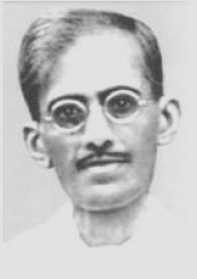
K. Ananda Rau
|
Marshall Harvey Stone, a mathematician of high repute from the University of Massachusetts, for example, regards Ananda Rau as a mathematician of distinction and a powerful analyst. Ananda Rau’s students, S. Chandrasekhar, K. Chandrashekaran, S. Minakshisundaram, S.S. Pillai, C.T. Rajagopal, M.V. Subbarao, and T. Vijayaraghavan blazed new trails in Indian mathematics. Besides being an affectionate teacher to his formidable students, Ananda Rau studied several mathematical themes – summability of series and of general Dirichlet series, functions of a complex variable, representations of numbers as sums of an even number of squares – and published 24 high quality papers. He provided a converse of Abel’s theorem in 1928, which has come to be known as the Ananda Rau theorem in Tauberian Mathematics.
Born in Madras on September 21, 1893, Ananda Rau studied at the Hindu High School (Triplicane) and completed his BA (Honours) in Mathematics from Madras Presidency College in 1914. On August 1, 1914, Ananda Rau sailed to Cambridge from Bombay, just 150 days after Ramanujan went to Cambridge. At Cambridge, Ananda Rau cleared the Mathematical Tripos Part I examination in 1914 and Part II examination in 1915, and secured a proficiency mark in advanced pure mathematics of schedule B. During his stay in Cambridge, he was first elected an Exhibitioner and, later, a Scholar of King’s College. He won the Smith’s Prize in Cambridge in early 1918. Most of his study took place under the direction of Godfrey Harold Hardy (1877–1947). Madras residents will recall Hardy
as Srinivasa Ramanujan’s teacher and mentor.
Hardy writes of Ananda Rau: “Mr. K.A. Rau spent the last year in mathematical research, undertaken in part under my advice. Some of his results are contained in an essay which obtained the Smith’s Prize this year; and he has done other valuable work which will no doubt be published in due course.”
On his return to India, Ananda Rau was appointed Professor of Mathematics in the Madras Presidency College in 1919. He was an inspiring teacher who strongly believed that mathematics required immersion and dedication and was inappropriate for spectators. He was honoured with the title ‘Rao Bahadur’ by the then Government of India.
Komaravolu Chandrashekaran and Cadambatur T. Rajagopal got their Ph.D. degrees from the University of Madras with Ananda Rau as their principal adviser.
According to Cadambatur Rajagopal, Ananda Rau’s second half life was spent in silent suffering and dedicated studiousness. His life was full of tragic circumstances; his wife died young, in 1928, his daughter in 1940 and, in the final years of his life, he became blind in one eye. Despite this and other physical disabilities weighing heavily on him, his constant preoccupation was with numbers that could be expressed as specific sums of squares. He was also an enthusiastic gardener.
Ananda Rau died peacefully in Bombay in 1966.
Back to top
|
|
 |
| (By Savitha Gautam) |
|
First Indian voice on record
My Name Is Gauhar Jaan! The Life and Times of a Musician
Vikram Sampath (Rupa, Rs. 595)
Accidentally stumbling upon a box of archival material at the Mysore Palace, young author Vikram Sampath set off on a trail that changed the way he perceived music history. The box contained all kinds of information about a singer called Gauhar Jaan. Why was she so meticulously catalogued at the Palace? Who was she?
Well, to begin with, if Gauhar Jaan had not walked into a recording studio (of sorts) in November 1902 and sung into a horn (which served as a mike), today we would not be listening to music on iPods and iPads… For, she dared to become the first Indian voice on a gramophone record.
A legendary musician who could sing in 20 languages including English, Urdu and Tamil, Gauhar had over 600 records to her credit. Mind you, each of those records was just three minutes long!
And to think she was not even a native Indian language speaker. Gauhar Jaan was born of an Armenian Christian father and an Anglo-Indian mother in Azamgarh and baptised Eileen Angelina Yoeward. Hard times led her mother and she converting to Islam. Her mother was the indomitable Malka Jaan who was a prolific poet in her own right.
Besides the flamboyance and opulence with which Gauhar conducted her life when she was at the peak of her career, she was a splendid singer. And she influenced many, including our own Ariyakkudi who is believed to have learnt a song or two from her!
A great friend of Salem Godavari (Gauhar’s counterpart in South India), she came to Madras in 1910 and even learnt a Suruti kriti from Veena Dhanammal. The trip was musically enriching for her and others who came to listen to her sing.
Gauhar Jaan died a pauper at the KR Hospital in Mysore, but there is no grave to mark her final resting place. Her decline was her own doing, as she lamented in the grey years of her life.
Vikram’s hard work and hours and hours of poring over documents and archival material comes clearly through in the tome. The advent of the gramophone is described in detail. The turn of the century saw India embracing Western technology on the one hand and opposing British rule on the other. It was a time when decadence was slowly destroying cultural finesse, especially in Bengal where the British presence was overpowering.
The book not only resurrects the life of a pioneering recording artiste but also throws light on a society where hypocrisy and greed were the order of the day. That Gauhar Jaan made it while she could, says a lot about her. Go for this fascinating story if you are a lover of music and history.
* * *
The brothers at war
Empire Of The Moghul: Brothers At War
Alex Rutherford (Hachette-India, Rs. 495)
As a school student, I was al-ways enraptured by the Moghuls. Though angry with them for having annexed our land, I was also impressed with their creative pursuits, courage and determination to make an alien country their own.
It is perhaps this kind of fascination that led the husband-wife team of Michael and Diana Preston (whose nom de plume is Alex Rutherford) to dig deep into Moghul history and produce two books – one on Babur and the next on Babur’s son Humayun.
The second enthralling instalment, Brothers At War, is set in a 1530s Agra, where Humayun, the newly-crowned second Moghul Emperor, must now build on his father’s rich legacy, and make the Moghuls worthy of their forebear, Timur the Lame. But, Humayun is in grave danger as his half-brothers are plotting against him. Soon, Humayun is locked in battle with his siblings, not only for his crown, but for his very existence.
Humayun’s travels to Persia and his return to Agra to claim his throne after many years of struggle form the rest of the book. Humayun’s love for his wife and son Akbar, his moments of hesitation and despair, the pain when he discovers that his brothers will do anything to get the throne… the authors paint a humane picture of one of the most powerful emperors to sit on the Peacock Throne. Grab a copy... it’s simply unputdownable!
Back to top
|
|
|
|
|